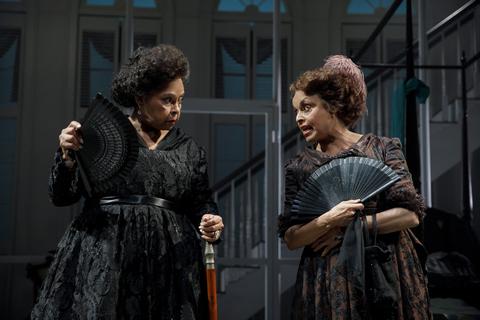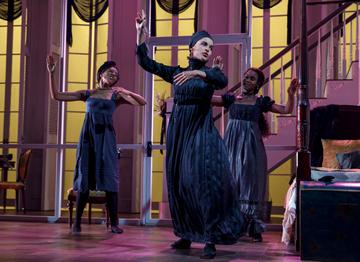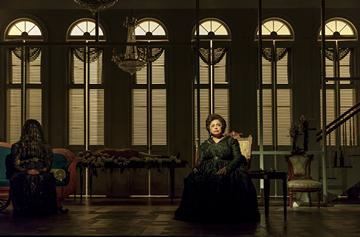The House That Will Not Stand
Marcus Gardley has refashioned Lorca’s tragedy “Bernarda Alba” as a powerful American play examining race relations in New Orleans after the Louisiana Purchase.

Lynda Gravátt and Marie Thomas in a scene from Marcus Gardley’s “The House That Will Not Stand” (Photo credit: Joan Marcus)
[avatar user=”Victor Gluck” size=”96″ align=”left” ] Victor Gluck, Editor-in-Chief[/avatar]Like Marcus Gardley’s A Wolf in Snakeskin Shoes which transfers Moliere’s Tartuffe to present day Atlanta, his The House That Will Not Stand, now having its local premiere at the New York Theatre Workshop, adapts Federico García Lorca’s The House of Bernarda Alba to an American setting. However, Gardley whose family came from New Orleans has a different agenda than did Lorca in resetting the play from Spain to Louisiana. Despite the changes, this powerful but talky new play which had its premiere in the Berkeley Repertory Theatre in 2014 has the strengths and weaknesses of the Lorca original.
Gardley makes use of a little known piece of American history: while Louisiana was under Spanish and later French rule, it had a three-tiered racial system. Aside from white settlers and black slaves, there was a third class: free women of color (mostly Creoles) could enter into a relationship with white men as common-law wives. Their children could inherit part of their estates. Some of these so-called “colored” women became extremely rich. This system was called plaçage and such women were known as placeés. The lighter the woman’s skin color the higher her social caste. However, when Louisiana was sold to the new United States in 1803, this system was frowned upon and eventually went out of style around 1813 due to legal challenges.
Set in the summer of that year, 72-year old Lazare Albans has died leaving a wife and his mistress/widow Beartrice. He and Beartrice have three unmarried daughters of varying skin-tones: Agnès, aged 19, Maude Lynn, 18 years old, the middle daughter and the lightest in skin color, a very religious woman wedded to her prayers, and Odette, aged 16, the most beautiful but the darkest of the three. Beartrice, a strict martinet, has kept her daughters from going to the local balls in order to keep them from becoming placées. However, both Agnès and Odette are in love with Ràmon Le Pip, one of the richest men in New Orleans, who has also expressed an interest in Agnès, but has not yet seen the beautiful Odette. Beartrice tells her daughters they are to go into mourning for their father for the next seven months and not leave the house. However, Ràmon is waiting for Agnès at tonight’s ball and Odette is also psyched up to attend, regardless of Maude Lynn’s caution.

Nedra McClyde, Juliana Canfield and Joniece Abbott-Pratt in a scene from Marcus Gardley’s “The House That Will Not Stand” (Photo credit: Joan Marcus)
Aside from her daughters, Beartrice rules over two other women: her half-crazed sister Marie Josephine who attempted previously to run off with a black musician, and her black Haitian slave Makeda who is said to know voodoo. Makeda has been promised her freedom but La Veuve, a free woman of color and Beartrice’s sworn enemy, who comes to pay a sympathy call, warns Makeda that with transfer of Louisiana from Napoleon to the United States things will change the next morning: “All the free people of color who don’t have wealth or property will lose their rights and slaves will lose any chance of buying their freedom. Most of the free people of color have already fled to Paris but your Madame Beartrice refuses to give up this house – she’s that stubborn.” In the course of 24 hours, all things will change for Beartrice and her three daughters, proving that they live in a house that will not stand and with a racial caste system about to be challenged
Aside from reducing the number of daughters from five to three, Gardley has shortened Lorca’s cast of characters from 17 speaking roles down to seven and eliminated the chorus of Women Mourners. The aged mother and grandmother has been changed from the 80-year-old senile María Josefa to the 40-year-old sister Marie Josephine who is kept locked in the attic like Bertha Mason in Jane Eyre. His play is in two acts rather than Lorca’s three. In both plays the matriarch Beartrice/Bernarda is very unsympathetic – though we understand the reason for her possessiveness and overprotectiveness. Too much of both plays cover the same ground over and over: with the death of the father, what will she inherit; will the daughters find love; what is their position in the community; and which sister will get the handsome and rich lover. Nevertheless, both plays written in highly poeticized language ultimately exert great power as the story reaches real tragedy.
Lileana Blain-Cruz’s direction is assured, crystalline and sharp with all of the characters making indelible impressions in very distinctive roles. As matriarch Beartrice Albans, Lynda Gravátt is authoritative and imperious, a woman you dare not deign to cross. As her servant Makeda, Harriet D. Foy is the salt of the earth, a point Beartrice makes near the end when she says “She shall still be the foundation/ Of a nation that was raised by her hand.” As the widow La Veuve, Marie Thomas is amusing in the extent that her vicious rivalry with Beartrice takes her. Michelle Wilson is mostly wasted as the frenzied and deranged Marie Josephine who may just be the wisest one of them all.

Nedra McClyde and Lynda Gravátt in a scene from Marcus Gardley’s “The House That Will Not Stand” (Photo credit: Joan Marcus)
The biggest contrast is among the three daughters and the story mainly revolves around them. Nedra McClyde’s Agnès is pragmatic as well as cunning in her plans to break out from her mother’s rule. As Maude Lynne, the religious daughter with a name that is pronounced like “maudlin,” Juliana Canfield is intense and fierce about her love for the church, to the point of betraying her wayward sisters. Joniece Abbott-Pratt makes the youngest sister, Odette, naïve, romantic and starry-eyed. It is her decision that precipitates the final moments of the play.
While Adam Rigg’s large elegant parlor with its nine sets of French doors and elaborate crystal chandeliers with twinkling candles alongside the sisters’ bedroom with a four-poster bed sets the scene for the mansion in Faubourg Tremé in 1813 New Orleans. However, Yi Zhao’s lighting tends to avoid creating much atmosphere aside from occasionally bathing the stage in various colored mood lights. Montana Levi Blanco has designed beautiful, flattering 19th century gowns for all of the women. Justin Ellington’s lovely, original music is redolent of New Orleans with its jazz undertones. Raja Feather Kelly’s movement includes Makeda’s voodoo ceremony and the sisters’ ballroom dancing lesson.
Marcus Gardley’s The House That Will Not Stand is a challenging play both for its dense poetic language and its use of unfamiliar and startling American history. Under Lileana Blain-Cruz’s direction, her cast of seven seems to be living their roles rather than acting them. Although long at two hours and 15 minutes, the play’s dramatic payoff is one you will not want to miss. The House that Will Not Stand is ultimately an important historical American drama which takes us on a roller coaster of emotions.
The House That Will Not Stand (extended through August 19, 2018)
New York Theatre Workshop, 79 E. 4th Street, in Manhattan
For tickets, call 212-460-5475 or visit http://www.nytw.org
Running time: two hours and 15 minutes including one intermission






Leave a comment